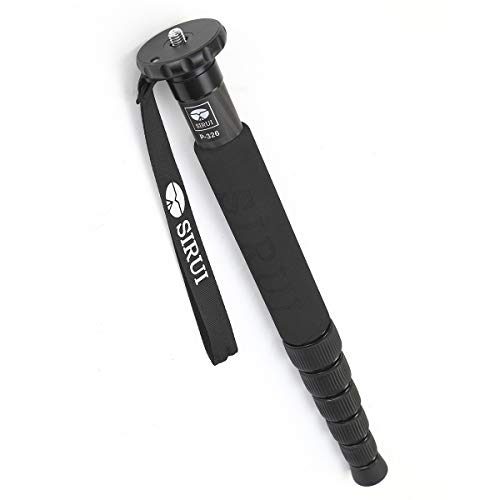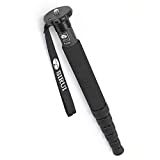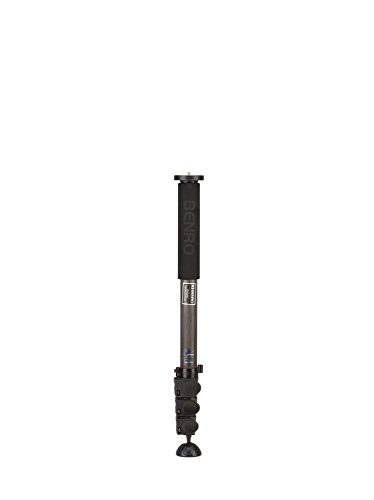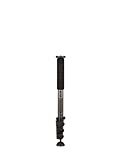Hey, you! Yes, you! Are you a professional, amateur, aspiring, OR frustrated photographer? Fear not, wannabe National Geographic photographers, for the most in-depth monopod review is here!
Now that our old school ad spiel is out of the way, keep in mind that this is an ACTUAL monopod review.
We’ll take you through a roundup of the BEST MONOPOD for wildlife photography, along with some honorable mentions below.
A Roundup of the Best Monopods For Wildlife Photography
As we go through this in-depth review in search of the best monopod for wildlife photography, we need to set some measures and ratings to make sure that we cover and review the list equally through fair judgment.
With this, we’ll be listing down the specifications, pros, and cons for each monopod, as well as a rating to interpret each item better.
The monopods will follow a five-star numerical rating scale, with 5/5 being the highest and 1/5 being the lowest.
The Sirui P 326 Monopod – Best Overall
Specs
- MATERIAL: Carbon Fiber
- WEIGHT: 0.88 lbs
- MAXIMUM HEIGHT: 60.6 In
- FOLDED HEIGHT: 14.9 In
- BUBBLE LEVEL: No
Rating: 5/5
As far as finding the best monopod for wildlife photography can go, the readily available, ever-sought-after The Sirui P 326 Monopod is definitely a head turner.
Known for its great image stabilization and build quality, it’s easily the go-to monopod for wildlife photography.
Made of high-quality carbon fiber, The Sirui P 326 Monopod is still lightweight and compact enough to carry around on your wildlife adventures.
You can also easily mount your camera rig because of the expertly designed ball head that comes with a quick-release plate. It comes with a wrist strap for better hold and stabilization.
Amazing video footage is easy to come by because of its build quality too.
After all, the best monopods should have all these qualities of robustness, steadiness, and compactness while supporting the photographer and his or her heavy-duty telephoto lens-based camera rig.
Pros
- Comfortable wrist strap and grip that helps you when on-the-go
- Extremely lightweight and perfect for professional and leisure use
- Carbon fiber composition to withstand wildlife photography situations
- Excellent value for money
Cons
- When not properly taken care of, it can easily break
Vanguard VEO 2 AM-264TR – Best Value
Specs
- MATERIAL: Aluminum
- WEIGHT: 1.9 lbs
- MAXIMUM HEIGHT: 64.6 in
- FOLDED HEIGHT: 22.5 in
- BUBBLE LEVEL: No
Rating: 4/5
When it comes to great image stabilization, you can never go wrong with the Vanguard VEO 2 AM-262TR.
Vanguard has long been recognized for its three-legged structure, whether it be for a tripod or monopod. It’s popular because it truly proves its claim of supporting a heavy-duty camera and lens.
The Vanguard VEO 2 AM-262TR also comes with a retractable foot, in case you prefer a single rubber nub instead.
This monopod also comes with twist locks allowing for a quick setup process, while the rubber grip gives you a tighter hold, making it more convenient for long hours in the wild.
Pros
- Foldable feet for extra stability
- It comes with a wrist strap for better movement
- It has three-legged leg locks
- Value for money considering its durability
Cons
- Heavier weight compared to others
The Manfrotto Compact Extreme – Best Budget Pick
Specs
- MATERIAL: Aluminum
- WEIGHT: 1.34 lbs
- MAXIMUM HEIGHT: 51.57 In
- FOLDED HEIGHT: 16.14 In
- BUBBLE LEVEL: No
Rating: 3.5/5
With Manfrotto being a popular and recognized brand in the world of photography, it doesn’t come as a surprise to be on our list!
This is perhaps the best monopod for wildlife photographers in the entry-level department because of its budget-friendly price.
Wildlife photography means being in unfamiliar territory, but the Manfrotto Compact Extreme is a reliable choice for image stabilization.
If you’re in the beginning stages of wildlife photography, this won’t hurt your pockets either.
Pros
- Cost-efficient
- Quick and easy to mount and unmount camera rig
- Impressive and interchangeable ball head
- Customizable performance
Cons
- Adequate build quality and materials
- Not recommended for portfolio-level work
3 Legged Thing Alan
Specs
- MATERIAL: Carbon Fiber
- WEIGHT: 1.34 lbs
- MAXIMUM HEIGHT: 58.7 in
- FOLDED HEIGHT: 17.3 in
- BUBBLE LEVEL: No
Rating: 3/5
A reputable heavy-duty monopod in its own right, the 3 Legged Thing Alan can carry an outstanding 60kg worth of weight, making its maximum load capacity incredibly difficult to ignore.
With that kind of build, you definitely won’t have to worry about adjusting your camera kit according to the monopod.
One downside to this beast of a camera kit is its shorter height compared to other monopods, which may not be the best choice for taller photographers.
The price tag on this is also justifiable, considering all the features of the item. It’s an investment worth making!
Pros
- Lightweight monopod that can carry heavy loads
- Can convert into a microphone boom
- Big grip for maximum grip with water dispersing channels
Cons
- Not suitable for taller photographers
- It only folds to 17.2 inches, making it slightly harder to pack
Manfrotto Xpro 5-Section
Specs
- MATERIAL: Aluminum
- WEIGHT: 2.65 lbs
- MAXIMUM HEIGHT: 75.59 in
- FOLDED HEIGHT: 26.77 in
- BUBBLE LEVEL: No
Rating: 4/5
If you’re looking for the best monopod that is built to withstand the harshest and most careless of treatments, you can’t go wrong with the Manfrotto Xpro 5-Section.
Being in the field of wildlife photography can mean long hours in uncharted areas, never really knowing when you’ll need to start running or loading things to get the perfect shot.
This is the best monopod you can rely on to withstand you in all your chaotic photographer glory.
Its height also DOES NOT hinder the monopod from being a lightweight and travel-friendly option for excellent image stabilization.
With the quick power locking system in hand, you’re guaranteed a fool-proof wildlife photography experience.
Pros
- Compact and lightweight for packability
- Fast and secure legs for movements and stability
- It won’t break even after all your careless movements
Cons
- It’s a pretty expensive monopod compared to its predecessors
Benro Adventure 3 Series Carbon Fiber Monopod
Specs
- MATERIAL: Carbon Fiber
- WEIGHT: 1.1 lbs
- MAXIMUM HEIGHT: 62.4 in
- FOLDED HEIGHT: 20.67 in
- BUBBLE LEVEL: No
Rating: 3.5/5
When it comes to finding the best monopod for wildlife photography, you’re always going to want to consider how effective it is while being on the go.
The name speaks for itself as adventurers need a monopod counter that can keep up with their lifestyles.
This would require a monopod with lighter weight without sacrificing great image stabilization.
You’ll have no problem capturing 360-degree video footage as this kit rotates quite sturdily as well, being able to hold heavy items such as a telephoto lens.
Pros
- You can literally take it with you anywhere because of how light weighted it is
- It’s easy to fold and unfold
Cons
- It tends to rust quicker in humid environments
- It can hold a maximum weight of 35.3 pounds only
What Makes for A Great Monopod?
Any wildlife photographer and videographer will know that when shooting on the go, your hands NEED to be STEADY if you want that perfect shot.
The steadiness of a photo can affect the photo’s quality, especially when the lighting isn’t great.
Before we get into the nitty-gritty and nerdy performance details, here’s a brief definition of a monopod.
What Is a Monopod?
Think of a monopod as a FLAMINGO version of a tripod. It stands on one leg, looking eternally gracefully while it’s at it, all while maintaining perfect balance and steadiness. Flamingo things only.
If you ask me, they should have just called the thing a flamingopod. (You better not be stealing that idea from us right now.)
Anyway, the monopod (or flamingopod) is typically made of aluminum alloy or carbon fiber. The main menu includes a series of pop-up tubes in each one.
These tubes support your camera and can extend to your preferred height.
And while a tripod is great for photography, here are some drawbacks:
- It often takes MORE TIME to set up and mount the camera rig on,
- It is MORE SPACE-CONSUMING than a lightweight monopod.
These are precisely why many prefer a monopod over a tripod when it comes to wildlife photography.
When buying a monopod for wildlife photography, spare yourself from the hassles of searching for the perfect one by watching out for these key functions:
Best Monopod Qualities
- Steadiness– It has to be ever-reliable and unwavering
- Lightweight – It allows you to carry it around all day hassle-free
- Compact – Make sure it’s space-saving enough to fit in your bag
- Durability – Because why waste your hard-earned money on one that won’t last long?
- Easy set-up – Because the last thing you need is a pesky monopod ruining your picture-perfect momentum
Other Considerations
Aside from all these qualities that photographers should watch out for, you’re also going to want to look at the specs to make sure it’s suited for your camera. That’s a given.
Besides going over the specs and features, make sure to add these to your main menu when considering your purchase:
Cost
You’ll be surprised to know that a monopod’s price range is pretty wide despite a fairly straightforward design and composition.
A good, not-so-heavy duty monopod will set you back by $100, while a heavy camera may require a more advanced monopod with a heftier price tag.
Remember to set a budget range in mind before you go out shopping for monopods.
Reading articles and reviews (such as this one) will also give you a broader understanding of what you need to look for to ensure that you’re investing your money in the right item.
Quality
Wildlife photography entails being in unexpected situations, and this includes unpredictable weather.
Whether it be humidity, rainfall, or intense heat, make sure that your chosen monopod can withstand such photography conditions.
Ideally, similar to a tripod used for these situations, monopods should be waterproof as well. This will help preserve your monopod’s product life more.
Weight
With carbon fiber and aluminum being the main materials of most monopods, this means a lightweight monopod won’t be hard to come by.
Lighter weight means more mobility for the photographer, which will come in handy during long periods of wildlife photography.
Packability
Some opt for a monopod over a tripod because of how easy it is to fit a monopod into a backpack. Just be wary because not all monopods have the function of folding small enough into a pocket.
A tripod can be tricky to set up, which is why monopods make for a BETTER ALTERNATIVE to keep you on your feet longer. This makes it easier to carry around as you move from one place to another.
Load Capacity
When buying a monopod for wildlife photography, you are mounting more than just a heavy camera onto it.
Though mirrorless cameras are lighter, we must consider that a long lens such as the telephoto lens can sometimes be heavier than the camera itself.
In any case, a smart photographer would know better than to use up all of his or her energy on supporting the camera. This is exactly why you will want a monopod with a high maximum load capacity.
Make sure that your chosen monopods can hold a heavy camera well.
Mount
Monopods with extendable feet are typically better for those who want to ensure excellent image stabilization. This makes for the best performance for nighttime wildlife photography.
Just be aware that they might be slightly heavier and harder to set up.
Extension Length
Note that not all monopods will have the same height capacity. Consider what occasions you will be using the monopod for.
In wildlife photography situations, you’ll need one that has a wide range, angle, and reach to help you adapt to the different situations you may find yourself in.
Adaptability
This is a quality that ALL wildlife photographers should remember in the search for great monopods. Given the variety of situations, you HAVE to know if your monopod can keep up with you.
Unfortunately, there is NO BETTER WAY to know what works best for you than by trying many monopods.
NOTE: Comfort varies per photographer, but a key to finding the right one is through making a list of your own preferences to have proper evaluation when buying.
What Are the Main Features of a Monopod?
When scouring for the best monopods for wildlife photography, there are some key features you need to keep an eye on.
These ensure that you’re getting your money’s worth and saving yourself from trial and error purchases.
A material composed of carbon filaments, which are typically used on monopods because of their durable and lightweight composition.
A monopod’s minimum height, meaning how tall or short it is when packed or folded.
A type of long lens used to capture subjects from a longer distance, making it a staple for wildlife photography. Good monopods should be able to support such lenses.
A tool that is used to determine if the monopod’s surface level is BALANCED.
The Best Monopod for Wildlife Photography: A Recap of Our Top Picks
The Manfrotto Compact Extreme – Best Budget Pick
What if I can’t afford the other monopods featured on the list?
R-E-L-A-X! We have the best budget option that is still capable of providing for your photography needs.
An impressive stabilization feature along with a customizable photo and video performance helps the affordable monopod keep up with the other high-end monopods.
Vanguard VEO 2 AM-264TR – Best Value
The Vanguard VEO 2 AM-264TR serves as a worthy runner-up to the Sirui monopod. Its value for money will have you wanting to buy the product ASAP!
A tight strap, three-legged locks, and foldable legs contribute to the overall durability of the product.
You won’t have to worry about putting your money in the wrong place because these characteristics prove otherwise.
Sirui P 326 Monopod – Best Overall
If we’re talking about a monopod that ticks all the boxes in terms of features and qualities (like the ones we mentioned above), The Sirui P 326 is an easy winner for the BEST PERFORMANCE MONOPOD.
Its lightweight size, impeccable build quality, and superior stabilization are more than enough to exceed this product from its counterparts.
Basically, you get the COMPLETE PACKAGE and then some!
Final Thoughts
Don’t get us wrong, because every item on this list is worth an honorable mention. Regardless of your level of expertise or interest, there is BOUND to be one that is suited for you.
Always remember to take note of the following to make sure you get your money’s worth:
- Cost
- Quality or Durability
- Weight
- Packability or Portability
- Load Capacity
- Mount
- Extension Length
- Adaptability
Did you find this article helpful? Share your thoughts, experiences, and suggestions in the comment section below.










